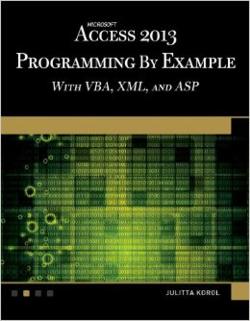| Microsoft Access 2013 Programming by Example with VBA, XML and ASP |
|
Author: Julitta Korol Aimed at non-programmers wanting to become programmers in Access, this book has been updated to cover Access 2013,
As in earlier releases, most of the book is taken up with showing how to program in VBA for Access. Julitta Korol starts from the basics of writing code in Access, with chapters on the Visual Basic Editor, and topics such as what variables are, how to pass arguments to procedures and functions. Given the intended audience, this is material that has to be covered. There are chapters on Ifs and loops, arrays and collections and class modules, and two final chapters on learning to program – the debugging tools and conditional compilation and error trapping.
Korol then moves on to programming in VBA with DAO and ADO. The number of different ways to do essentially the same thing has been a source of frustration for Access programmers for years now, and things don’t get any easier. Kobol does a good job of pointing out the options available, and how to make connections using the different choices, but doesn’t really say ‘use xx rather than yy’ at all. She then shows how to create tables and fields using VBA. I found this a strange place to start; if you’ve got Access, creating tables using code is something few programmers would have to do, and few would choose to, nor would you really set up primary keys, indexes and table relationships from code, which is covered next. From here onwards, the book gets more useful to people who can already program, with good coverage of working with DAO and ADO recordsets. What I think of as the central element of ADO/DAO programming– creating and running queries, database security, and replication.
The next part of the book covers the use of the Jet Data Definition Language. This gives developers a way to use Access via the SQL subset it supports. It covers similar ground to the earlier section using Jet, with the addition of a chapter on views and stored procedures. The next section of the book is where most Access developers will dive in. The theme of enhancing the user experience covers enhancing Access forms, using form events, enhancing reports, using advanced event programming, and programming the user interface. Rather oddly, the book then goes back (in terms of sophistication) to look at macros. The last section of the book has seen the most updating in this new edition, with a chapter on Access and Active Server Pages, and a closing chapter on the XML features of Access 2013. If you’ve an earlier edition of the book, you won’t find a lot of difference in the material, it’s just been updated to ensure it works with Access 2013. The companion CD contains source code, supplemental files and colour screen captures - although the fact the screenshots are in black and white isn't a problem. This book starts off by assuming the reader knows no programming, has never seen a variable or a loop. If you are in that position, and you want to go from being a non-programmer to developing full Access applications, you would be able to get there using this book. If you already know how to write code, and want to know how to work with the mess that is Access VBA, this book is still worth reading as when Korol is writing on this, she writes well. You can simply skip the first half that works through more basic programming.
|

